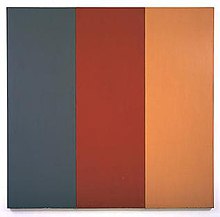Brice Marden
Nicholas Brice Marden Jr. (October 15, 1938 – August 9, 2023) was an American artist generally described as minimalist, although his work has roots in abstract expressionism, color field painting.
from the Yale School of Art in 1963, where he studied with Esteban Vicente, Alex Katz, Jon Schueler, Jack Tworkov, Reginald Pollack, Philip Pearlstein, and Gabor Peterdi.
Among his fellow students were the future artists Richard Serra, Chuck Close, Janet Fish, Vija Celmins, Nancy Graves, Gary Hudson, and Sylvia and Robert Mangold.
[5] It was at Yale that Marden developed the formal strategies that would characterize his drawings and paintings in the proceeding decades: a preoccupation with rectangular formats, and the repeated use of a muted palette.
[6] It was also in Paris that he admired the work of Alberto Giacometti and Jean Fautrier, although masters such as Francisco de Zurbarán, Diego Velázquez, and Édouard Manet also informed Marden's artistic practice.
[7] In the late 1960s and early '70s, a moment when painting was widely considered moribund, Marden gained international fame as the master of the monochrome panel.
[8] In 1977 Brice Marden was commissioned (after an invited art competition with artists Samuel Buri, Joseph Beuys, Alfred Jensen, Jasper Johns, Roy Lichtenstein, Penck, Robert Ryman, Antoni Tàpies, and Jim Turrell) to design the windows lining the apse of the Basel Cathedral, a project that he labored on continuously from 1978 to 1985.
[12] Influenced in part by the Rothko Chapel in Houston, Texas, which the artist visited in 1972, Marden painted with the aim of fostering a heightened spiritual environment through abstraction.
The Basel commission saw the artist move away from the understated encaustic monochromes that dominated his output during the 1960s and 1970s to embrace a new, vibrant palette and set of linear compositional devices.
In part influenced by his growing interest in alchemy, he decided to work with combinations of colors limited to three (the Trinity) for the linear components and four (the elements - earth, air, fire, water) for the monochrome panels.
[14] In 1977, Marden traveled to Rome and Pompeii, where he strengthened his interest in Roman and Greek art and architecture, which would influence his work of the late 1970s and early 1980s.
[15] In 1983, Marden and family traveled to Thailand, Sri Lanka, and India; the artist became fascinated by the art, landscape, and culture of parts of Asia.
Marden subsequently incorporated numerous elements of certain Asian traditions into his work, making them one key to his process (the Shell Drawings, 1985–87).
A visit in 1984 to the exhibition Masters of Japanese Calligraphy, 8th-19th Century, encouraged Marden to use form, a predominant influence in his recent work—which can be seen in his acclaimed Cold Mountain series, both paintings and works on paper, 1989-1991.
Combining airy calligraphic scaffoldings of line with whitish or palely tinted backgrounds, these 9-by-12-foot paintings were the biggest Marden had created up to that point.
The MoMA called the exhibition "an unprecedented gathering of [Marden's] work, with more than fifty paintings and an equal number of drawings, organized chronologically, drawn from all phases of the artist's career.
[9] At the time of his death the artist had a Manhattan studio in a 10th-floor[5] penthouse duplex on West Street with around 5,000 square feet of space and one two-story window looking onto the Hudson River.


